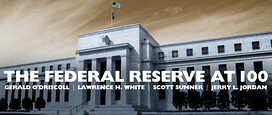Both Jerry O’Driscoll and Jerry Jordan have emphasized that switching from the rules-based regime of an international commodity standard to a discretionary national fiat standard dramatically loosens the fiscal constraints on the national government. Here are some numbers about how the Federal Reserve has responded to the removal of the gold standard’s constraint against accommodating the U.S. Treasury. The ratio of nominal gross federal debt to nominal GDP stood at 130 percent on the 1st of January 1946, following the Second World War. The monetary base stood at $33.3 billion. Twenty-four years later, on the 1st of January 1970, the debt-to-GDP ratio had fallen to 40%. How was that accomplished?
During the same period the Fed roughly doubled the monetary base (to $62.2b), and as a result the price level (CPI) had roughly doubled. (Real income had grown, of course, but so too had the velocity of the monetary base as a result of the rising inflation that the Fed had created.) The debt ratio fell because the doubling of the CPI contributed to expanding nominal GDP but did not increase the number of dollars owed on previously issued Treasury bonds. The holder of a 30-year Treasury bond issued in 1940-1946 saw more than half of the real value of its principal washed away by inflation. Inflation rates were even higher in the 1970s, such that by 1981 the debt ratio had fallen to its postwar low of 31%. Since then chronic and recently acute deficits have built the debt ratio back up.
In 2012, for the first time since the postwar erosion, the ratio of gross federal to GDP rose above 100 percent. The pressure on the Fed to once again help to erode the real debt is not to be dismissed. Once again the market yields on US Treasury debt do not incorporate any substantial premium for expected inflation. The absence of any rule that prevents unexpectedly inflationary monetary policy means that there is nothing tangible to stop the Fed from once again giving into the pressure to inflate enough in order to reduce the real value of the accumulated federal debt.

